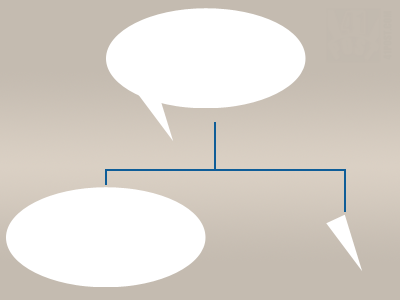Posts Tagged ‘Unity3D’
Posts that contain information about Unity3D game engine.
Unity: How to create a speech balloon
Posted by Dimitri | Filed under Programming
This Unity tutorial explains how to create a speech balloon, like the ones featured on comic books, in Unity3D. For any game, objects move around the screen, and in order to make the speech bubbles work, they have to follow the movement of these objects. However, the balloon can’t be translated in the 3D space, or else it will look like a regular billboard sign over the character’s head. So, it has to follow the character on the two dimensional screen space. The elongated edge of the balloon must also follow the character’s movement, stretching and shrinking accordingly.
To solve these two issues, a script is necessary, which will treat the round part and the triangular tip of the balloon separately.

The script will create a speech balloon by rendering these two parts separately. They must have the same color to create the illusion that it's a single element.
Unity: Creating a texture from a XML file
Posted by Dimitri | Filed under Programming
This Unity3D programming tutorial explains how to read a XML file from the Resources folder and use the pixel color data defined there to create a Texture2D object. Basically, it’s the same as creating a texture from an array, but this array will be obtained from a XML file, instead of being defined in the script.
Since even a small image uses a large amount of tags on the XML file, an example project is available for download at the end of the post. This sample project has a XML file with 4096 items, that creates a 64×64 texture.
Unity3D: Using textures larger than 4096×4096
Posted by Dimitri | Filed under Featured, Programming
This post explains how to assign images larger than 4096×4096 px as textures in Unity. This image size is the maximum supported dimension for a texture in that game engine, however Unity allows us to write our own custom shaders that can use four images as textures, instead of just one.
Therefore, this post shows how to create a simple diffuse shader that takes four images to compose a single texture. That way, a 8192×8192 image can be used as a texture by breaking it into four 4096×4096 pieces, thus respecting the engine’s image size limit.
Unity: Scaling Pixel Art
Posted by Dimitri | Filed under Programming
This Unity post explains how to prepare images and set the Texture Importer settings to correctly render pixel art in Unity3D. So, this post covers how the different Texture Importer settings affects the pixel art textures in 3D models and in the game’s graphical user interface (GUI).
Unity: Slow Motion and Rigidbody behavior
Posted by Dimitri | Filed under Featured, Programming
It’s been awhile since the last Unity post, in fact, it’s been quite some time since there’s something new on the website. I want apologize to all the 41 Post readers for taking so long to put together a new tutorial. So, let’s get to the tutorial.
This post explains how to set the parameters found at Unity’s Time class to make the game run in slow motion (also known as “bullet time”). It’s important to note that the following code was created for Unity3D 3.4, thus, the code featured below might work different in other Unity versions. (more…)


